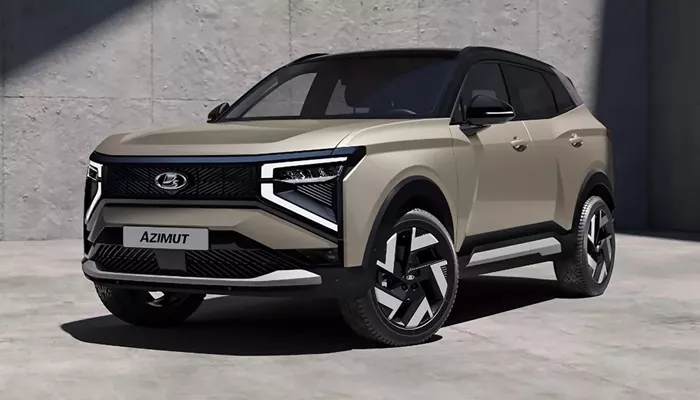Despite ongoing challenges from the war in Ukraine and international sanctions, Russian automaker Avtovaz has introduced its first new Lada crossover in almost three decades.
Instead of releasing the long-awaited new generation of the Niva, the company revealed the Azimut. This five-door SUV features sharp, modern styling that resembles a new Dacia model. The Azimut is planned to launch in 2026 and is claimed to be fully designed, developed, and manufactured in Russia, as international partnerships are currently difficult.
The Azimut looks surprisingly contemporary for a Lada. It could compete with models like the Dacia Duster and Bigster. The front of the SUV shows Lada’s signature X-design pattern, a short front overhang, and sharp LED headlights integrated with the grille and bumper.
From the side, the SUV has distinct creases on the fenders, 18-inch alloy wheels, and two-tone paint with subtle plastic trim. At the rear, there is a full-width LED light strip between the taillights and a rear bumper with an aluminum-style insert.
Simple but Practical Interior
Inside, the dashboard appears familiar and somewhat plain. It features a digital cockpit with an instrument cluster and a 10-inch touchscreen for infotainment, which includes navigation and a virtual assistant. This software was developed with Russian firms Sber and Navio.
Standard equipment includes six speakers, a rear-view camera, and keyless entry. Optional features will include wireless charging, a panoramic roof, dual-zone air conditioning, heated side windows, an electric tailgate, and a 360-degree camera.
The cabin also offers multiple storage spaces and electric adjustments for the steering wheel and front seats. A rotary dial on the center console allows drivers to select different terrain modes.
Gasoline Engines Only
At launch, the Azimut will use gasoline engines without any electric options. Buyers can choose a 1.6-liter naturally aspirated engine producing 120 horsepower or a 1.8-liter engine with 132 horsepower. Both engines come with either a six-speed manual transmission or a CVT. A more powerful 150-horsepower turbocharged version with an automatic transmission is expected to be offered later.
The SUV is built on a modified version of the Vesta platform, originally introduced in 2015 and updated in 2022. This platform now features a new rear suspension and 208 mm (8.2 inches) of ground clearance, which is generous for a crossover. The development took three years and involved nearly 1,000 new or updated parts.
While the Azimut shows off-road design hints, it is likely to come with front-wheel drive only at first, similar to the Vesta sedan and wagon. However, Lada highlights its “all-terrain concept” and “cross-country ability,” suggesting a possible all-wheel-drive version in the future. These claims might also refer to its rugged look, ground clearance, and terrain selector.
Pricing and Availability
Production will start in 2026 at Avtovaz’s Togliatti plant. Due to the current war and sanctions, the Azimut is unlikely to be sold outside Russia soon.
Russian media estimate the starting price between 2.5 and 3 million rubles (about $31,900 to $38,300). This makes the Azimut the most expensive model in Lada’s lineup.
For comparison, the older Niva Legend starts at about 1,059,000 rubles ($13,500), and the newer Niva Travel begins around 1,314,000 rubles ($16,700). The Vesta sedan and wagon cost between 1,239,900 and 2,197,000 rubles ($15,800 to $28,000). The Azimut clearly marks a bigger step in both price and ambition for Lada.

